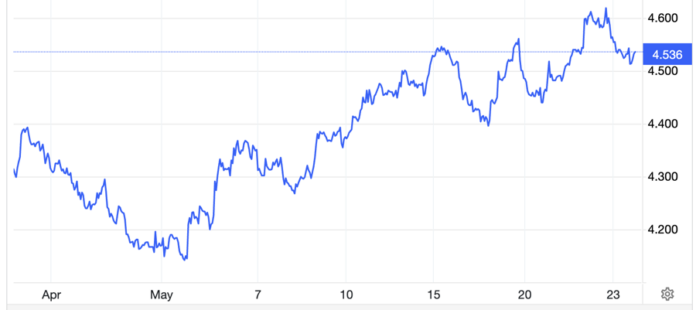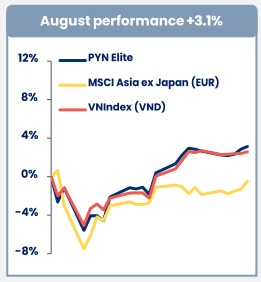A sell-off is intensifying in the global bond market after Moody’s Ratings downgraded the US credit rating and President Donald Trump’s tax bill raised investor concerns about Washington’s debt and budget deficit.
In an interview with CNBC, portfolio manager Rong Ren Goh of Eastspring Investments remarked that events such as credit rating downgrades or budget plans that increase the fiscal deficit tend to worry investors about fiscal issues. Due to this concern, the market will reassess long-term risks.
On May 22, the US House of Representatives approved the Republican tax and spending bill, which includes extending Trump’s 2017 tax cuts and increasing some spending, including on defense. According to estimates, this bill could add $3-5 trillion to the US debt over ten years. After House approval, the bill was sent to the Senate for a subsequent vote.
Earlier, on May 16, Moody’s downgraded the US sovereign credit rating from the top Aaa to Aa1.
These developments appear to have prompted investors to sell off US Treasury bonds and government bonds of some other major economies.
“The market doesn’t think Trump’s ‘big, beautiful’ tax bill is ‘beautiful’. US Treasury bonds have been hammered in a massive sell-off,” said Vishnu Varathan, executive director of Mizuho Securities, to CNBC.
The yield on the 30-year US Treasury bond exceeded the 5% mark for the second consecutive session on May 22, the highest since November 2023. The yield on the 10-year bond has risen more than 15 basis points since the beginning of the week.
This sell-off of US Treasury bonds follows a significant withdrawal of investors from American assets in April, mainly due to a loss of confidence in US assets, according to observers.
When selling US Treasury bonds in April, investors bought Japanese and German government bonds. But this time, they are selling US Treasury bonds and withdrawing from many other major bond markets.
The sale of long-term bonds in each market stems from different factors, but they share a common cause: increasing anxiety about fiscal policy. “These concerns are leading investors to reassess the term premium they demand to hold longer-term bonds,” said Goh.
On Thursday, the yield on the four-year Japanese government bond set a record at 3.689%. The yield on the 30-year Japanese government bond also reached 3.187%, close to its all-time high. The yield on the 10-year bond rose 9 basis points in the first four sessions of the week to 1.57%.

The sudden steepening of the Japanese government bond yield curve has several causes, but the main one is structural. Japanese life insurance companies, a major buying force in the country’s government bond market due to regulatory requirements, are no longer buying as much because they have essentially met those requirements, according to Bank of America.
In addition, the Bank of Japan (BOJ) is shifting its monetary policy towards tightening, which conflicts with the Japanese government’s high borrowing. This is also a reason for the sell-off of Japanese government bonds, according to Varathan.
The sell-off in the Japanese government bond market presents a bigger problem for US Treasury bonds. “As Japanese assets become cheaper and more attractive to Japanese investors, the withdrawal from US assets intensifies,” said George Saravelos, global head of forex strategy at Deutsche Bank, in a report.
German government bonds are also being sold off. The yield on the 30-year German government bond has risen more than 12 basis points this week, while the yield on the 10-year bond has increased by more than 6 basis points.
“Germany’s abandonment of the debt brake, along with increased European defense spending, signals the end of belt-tightening in Europe and a revival of the region’s economic growth prospects. This is certainly a catalyst for the bond sell-off,” commented Robeco strategist Philip McNicholas to CNBC.
German government bonds also face downward pressure due to larger budget deficits, a potentially structural issue, Varathan noted.
“Investors are not really fond of long-term bonds at the moment,” said Steve Sosnick, chief strategist at Interactive Brokers, to CNBC.
Moreover, global inflation concerns are another disadvantage for long-term bonds, according to Sosnick. He added that shorter-term bonds are more influenced by central bank policies, while longer-term bonds are more affected by investors’ expectations for the economy’s future.
In contrast to the developments in major bond markets, bonds of some emerging economies are being bought, leading to falling yields.
For example, the yields on 10-year Indian and Chinese government bonds have both fallen. However, it should be noted that the primary drivers in these countries’ government bond markets are domestic investors, partly due to strict capital controls. This week, the yield on the 10-year Indian government bond fell by about 2 basis points, while the yield on the 10-year Chinese government bond edged slightly lower.
“Foreign investors and global factors are not the determinants of the yield curve in these countries,” Sosnick emphasized.
















